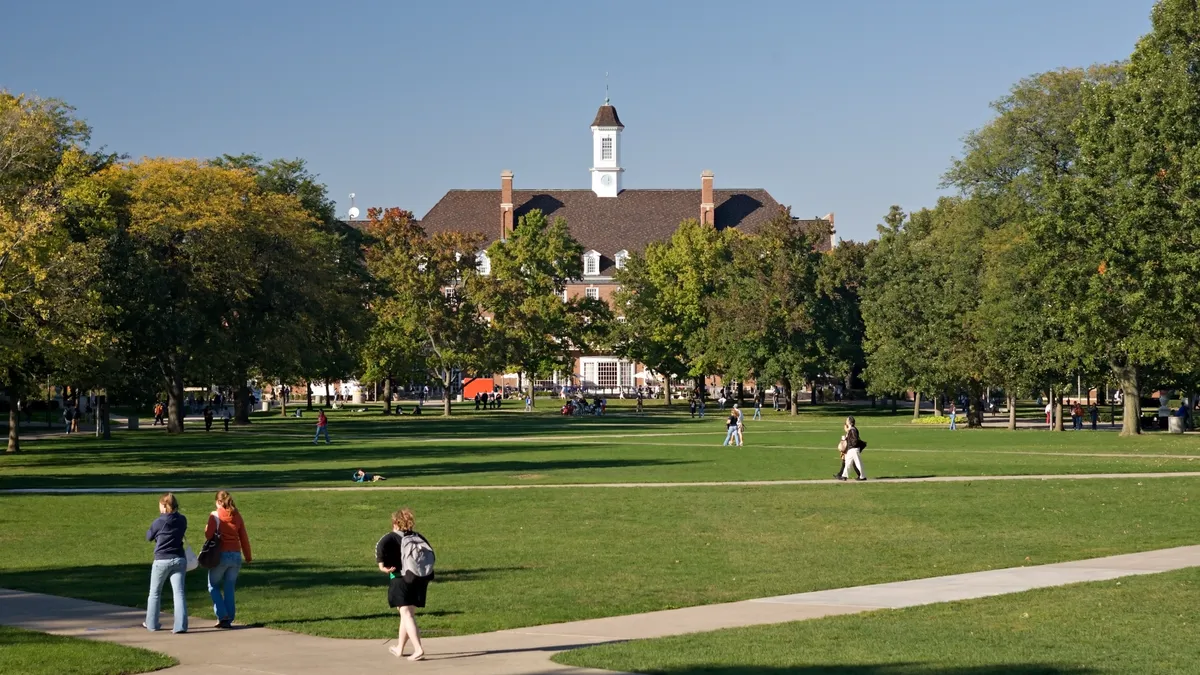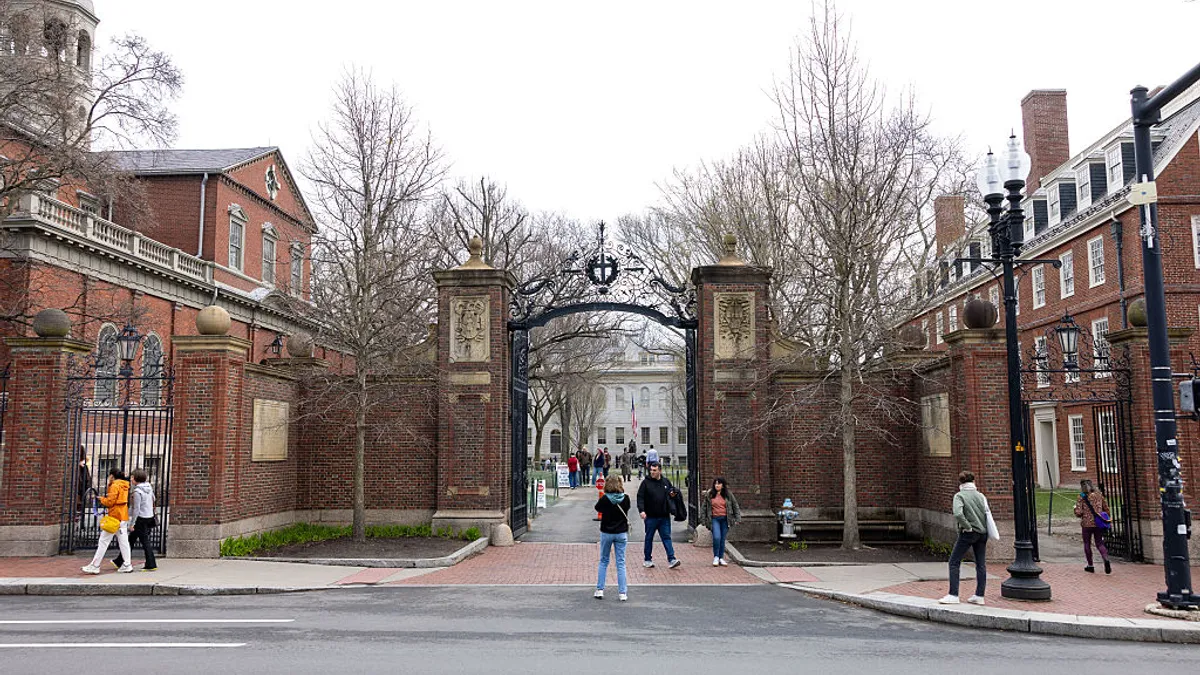Free college programs are making inroads at two-year institutions, with the goal of increasing access to postsecondary education by covering tuition and some fees for eligible low-income students. But a few leading contenders for the 2020 Democratic presidential nomination want to take the idea a step further, subsidizing the cost of a bachelor's degree at four-year colleges.
The idea they're pushing has some precedent. After years of rising tuition and declining state support, public four-year colleges and universities have begun increasing need-based aid.
In the last few years, some state institutions — including the State University of New York System, the University of Illinois at Urbana-Champaign (UIUC), the University of Tennessee and the University of Texas at Austin — have pledged to ensure that low- to middle-income students can attend for free, in some cases expanding existing efforts to do so. In Tennessee, this builds on the state's successful free college program at the two-year level.
Overall, state funding for need-based grants for undergraduates rose 7% to $8.9 billion nationwide between the 2016-17 and 2017-18 academic years, according to the latest annual data from the National Association of State Student Grant and Aid Programs.
Debate about free college on a national stage tends to focus on how ambitious (and expensive) these proposals should be and who ought to benefit from them. But for higher ed administrators, those considerations are the first of many factors that determine whether the initiatives will be successful. And current efforts to subsidize four-year degrees for some students at public colleges offer lessons for addressing them.
"People tend to get really excited about these programs, as well they should," said Megan Schneider, senior director for government affairs at the National Association of College and University Business Officers. "Our concern from the business office is that lawmakers get so excited about it that they forget there are a lot of less glamorous details — but no less-necessary details — that go into providing a higher education."
Finding the money
If the goal of such programs is to increase access to postsecondary education, a natural consequence is that more students will attend college. That could financially strain public universities, Schneider said.
As with two-year colleges, four-year schools must get creative with how they pay for the programs. UIUC is taking the money out of its existing budget. The University of Texas is using a slice of the funds it gets from oil and gas royalties on state-owned land. And the University of Tennessee is establishing an endowment to cover the costs.
Also at issue is how much of the bill the schools and students are each expected to foot.
Many current free college programs at two- and four-year institutions only cover the students' portion of in-state tuition. That means they don't account for additional operating expenses the institution may need to bear to accommodate an increase in students, especially those who may not be as academically prepared for college.
Students who are eligible for free college programs, meanwhile, often qualify for other forms of financial aid that reduce their expected tuition costs. But these sources typically don't cover expenses such as housing, meals, books, transportation and child care that can add up to make attending college unaffordable. Some advocates have called on free college programs to cover these costs, too.
Even the most generous program won't succeed if prospective students don't know about it. Ambitious marketing campaigns are sometimes used to publicize free-college efforts, requiring the universities to coordinate with other institutions, high school counselors and financial aid agencies. UIUC, for example, spent $300,000 on a statewide media blitz for the first year of its new free tuition initiative. It splashed messages about the Illinois Commitment on bus stops, highway billboards and even in ads that ran in movie theaters.
"It's easy to say, 'free college' without doing too much more work on it, but we should take the time to do the work," Schneider said.
Learning from New York and Illinois
Four-year institutions that already have free college programs offer lessons for wider adoption.
In 2017, New York became the first state to offer a free-tuition program for its two- and four-year colleges. Called the Excelsior Scholarship, it allows state residents whose families make up to $125,000 a year to attend the state's public universities tuition-free.
Support from Gov. Andrew Cuomo was key to getting the legislature to fund the program, said Patricia Thompson, assistant vice chancellor for student financial aid at the State University of New York (SUNY). But New York had already been generous with student aid, which made it easier for the state to set its income threshold twice as high as that of many comparable state programs.
This year, 24,000 students received Excelsior scholarships, up from 20,000 in the program's first year. The awards are applied on top of other financial aid, including New York's Tuition Assistance Program and federal Pell Grants. When all aid is counted, more than half (55%) of SUNY's 224,000 students don't pay tuition, according to local media reports.
Excelsior aid comes with significant restrictions, however. Recipients must be New York state residents, take at least 30 credit hours a year, and agree to live and work in the state for at least as long after getting the awards as they received them. Students who move out of state before then would have to repay their awards.
The requirements have raised eyebrows. The Center for an Urban Future reported that 68% of all applications for Excelsior scholarships were rejected in the program's first year; the vast majority of those applicants did not take enough credits to qualify.
The program is designed to help students focus on their studies and complete their degrees quickly, Thompson said, noting that 30% of Excelsior students at SUNY community colleges graduated within two years compared to 11% of non-Excelsior students. It's too early to tell the program's effect on graduation rates at four-year schools.
"If the goal is to get them across the stage, you do have to have rules to get them there," Thompson said. "Students will rise to the challenge and take those credits. It's not a bad thing to have requirements."
In Illinois, meanwhile, a two-year budget standoff in the statehouse delayed UIUC's plan to expand its financial aid, said Dan Mann, the university's associate provost for enrollment management.
UIUC is using its own funds to cover the cost of tuition and some fees for in-state students whose families earn up to $61,000 annually, which Mann said would apply to a third of Illinois residents. The Illinois Commitment scholarships will cost between $4.5 million and $5 million a year, he said, and for now will be paid for through increases in the university's financial aid budget.
One of the new program's goals is to draw more students from outside the Chicago area. In its first year, the number of students from central and southern Illinois grew by 18%, Mann said.
University officials have long been worried about the institution's affordability, particularly as its tuition has climbed, he said. In-state tuition cost nearly $4,300 in 1998 but more than $15,000 in 2018, according to data kept by The Chronicle of Higher Education. The university froze tuition for in-state freshmen each of the last five years, and in 2005 it began a free tuition program for students with less than $50,000 in total family assets.
Still, UIUC's in-state tuition rates were the second-highest among public universities in the Big Ten as of the 2018-19 academic year, behind Penn State. And UIUC continues to struggle to attract middle-class students who don't qualify for grants but can't afford tuition on their own, Mann said, which means they rely more heavily on loans and working while in school.
Any significant expansion of the Illinois Commitment would require new money, which is hard to come by. Mann is encouraged that the university found a way to go beyond its 2005 effort, but, he added, "hopefully it won't take us 15 years to get to the next step."




















